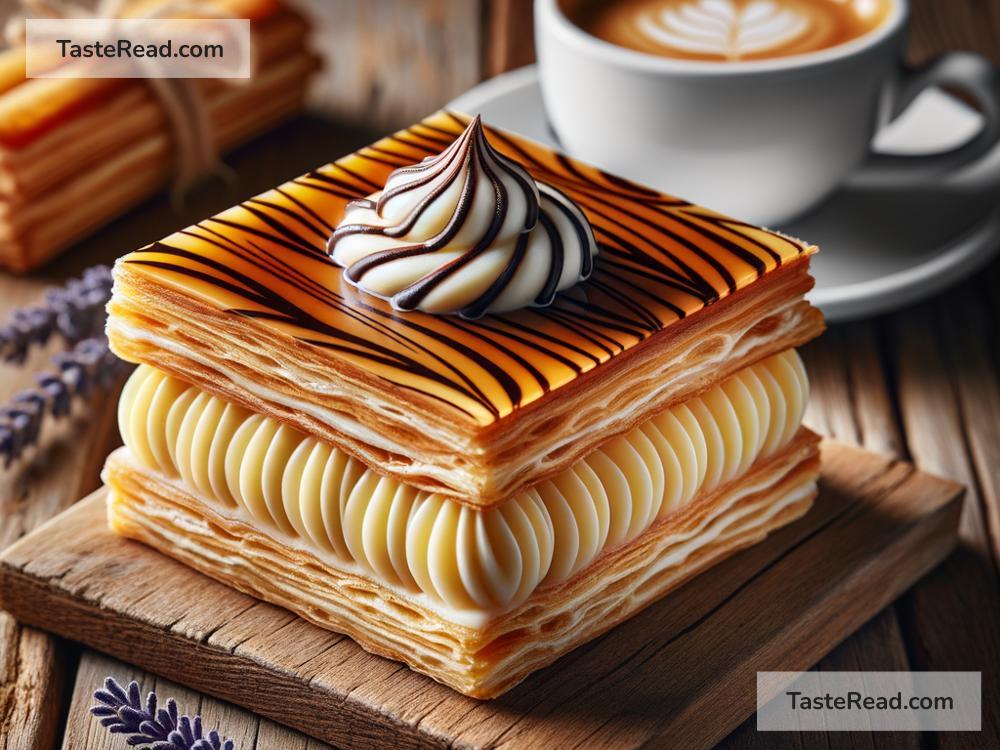The Origins of the French Mille-Feuille: A Delicious Layered Pastry
If you’ve ever visited a French bakery, you’ve probably seen the mille-feuille. This iconic pastry, known for its delicate layers and creamy filling, is a big favorite in France—and many other places around the world. But have you ever wondered where it came from? How did this fancy dessert get its start? Let’s take a journey through the history of the mille-feuille to understand its origins.
What Is a Mille-Feuille?
Before diving into the history, let’s describe what a mille-feuille is for those who may not know. The name “mille-feuille” means “a thousand sheets” in French. It’s a layered dessert made of puff pastry (thin, flaky dough), pastry cream (a rich custard), and powdered sugar or glaze on top. Some versions include fruit, jam, or whipped cream as extra layers.
Traditionally, a mille-feuille is composed of three layers of puff pastry and two layers of pastry cream. The top is often decorated with icing or a marble design using chocolate and white glaze, making it a treat not only for the taste buds but also for the eyes. Its light texture and creamy filling make the mille-feuille a favorite among pastry lovers.
A Mystery of History: Who Invented the Mille-Feuille?
Like many classic recipes, the exact origin of the mille-feuille is unclear. Pastries have existed in various forms for centuries, including layered ones, so pinning down who first made the mille-feuille is tricky. However, there are a few key moments in history that shed light on its development.
The first known mention of the mille-feuille is found in a French cookbook published in 1651 called Le Cuisinier François. This book was written by François Pierre La Varenne, who is considered one of the most influential chefs of his time. He didn’t call it “mille-feuille,” but described a layered puff pastry that shares many similarities with the modern dessert.
Later, in the 18th and 19th centuries, French chefs worked to refine pastry techniques, leading to improvements in puff pastry and cream fillings. Around the early 1800s, the term “mille-feuille” began to appear in written texts and recipes. By then, the layered pastry had become more recognizable as the dessert we know today.
The Role of Marie-Antoine Carême
One important figure who contributed to the mille-feuille’s evolution was Marie-Antoine Carême, a legendary French chef often called the “king of chefs and chef of kings.” Carême was famous for his elaborate creations and his work in refining French cuisine, including pastries.
Carême didn’t necessarily create the mille-feuille, but he perfected many techniques that made pastries more sophisticated and artistic. He popularized puff pastry as a foundational ingredient, and his work set standards for French baking that are still followed today. Some historians believe his influence played a big role in turning the mille-feuille into the elegant dessert we know.
Mille-Feuille and Napoleon: Is There a Connection?
You may have heard that the mille-feuille is also called a “Napoleon” in some countries. So, is this dessert connected to the famous French emperor Napoleon Bonaparte? Interestingly, the answer seems to be no.
The name “Napoleon” is thought to come from Naples, Italy, rather than Napoleon himself. It’s possible that the dessert’s name evolved because of confusion between “mille-feuille” and “Napolitain,” which could refer to Naples or Italian-style pastries. No direct historical link exists between Napoleon Bonaparte and this dessert—though many would agree it’s fit for an emperor!
Modern Variations of Mille-Feuille
Over time, the mille-feuille has been reinvented and adapted all around the world, leading to countless variations. In France, the pastry is most often made with vanilla pastry cream and a shiny glaze on top. However, other countries have put their own twist on the dessert. For example:
- Italy: Italian bakeries often add whipped cream and fruit layers to create lighter, more colorful versions.
- Russia: The “Napoleon cake” is a mille-feuille-like dessert with extra layers stacked high and sometimes uses condensed milk as the filling.
- United States: In American bakeries, mille-feuiles sometimes include chocolate, caramel, or raspberry jam for added flavor.
- Thailand: Thai mille-feuille recipes sometimes use tropical fruits like mango and coconut cream, blending French techniques with local flavors.
Chefs around the world continue to experiment with mille-feuille, proving that this pastry is endlessly versatile!
Why Do People Love Mille-Feuille?
The mille-feuille is beloved because it’s a perfect mix of textures and flavors. The puff pastry layers are flaky and crisp, while the cream filling is smooth and luscious. Each bite feels like a little indulgence. It’s also a dessert that looks as fancy as it tastes, making it popular for special occasions.
But beyond its deliciousness, mille-feuille carries history and tradition. It’s a reflection of centuries of French culinary artistry and dedication to detail. When you eat a mille-feuille, you’re tasting a little bit of history in every bite.
In Conclusion
The origins of the mille-feuille may be somewhat mysterious, but one thing is clear: it has earned its place in the hearts of dessert lovers worldwide. From its beginnings in early French cookbooks to its international variations today, the mille-feuille has remained a symbol of elegance and craftsmanship. The next time you enjoy one, remember that you’re part of a long tradition of pastry perfection—and don’t forget to savor the layers!


